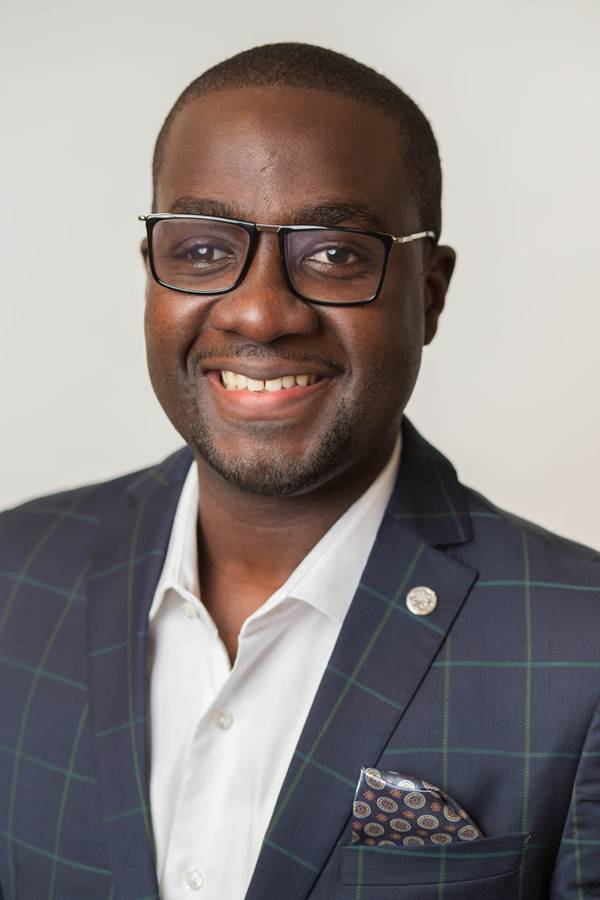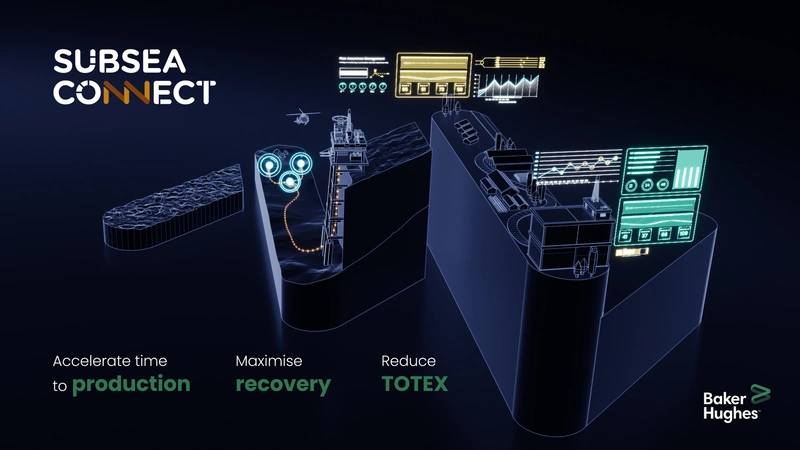
"We are doing something amazing in Baker Hughes,” said Alex Seinuah, the leader of Baker Hughes’ Growth Initiatives Hub. “I call the hub a start-up business. Within the hub we look at disruptive technologies and services that we believe will deliver value to our customers. Within the hub we look at digital specifically for production optimization, condition monitoring, remote support, smart IMR and asset integrity, which helps us baseline assets and develop fields for our customers.”
“Digitalization is all about leveraging digital technologies that will be an enabler and improve processes,” said Seinuah. “I spent more than five years offshore, and when I was out there, you had limited connectivity. If you needed to call the beach for support, the only way to make that call was to use the phone in the company man’s office; the only way to send an email was to use the company man’s laptop. When you’re stuck, you didn’t have any way to communicate with your team on the beach for support.”
Fast forward to today, and most DP rigs have good connectivity. “We can leverage that to provide remote support. We are leveraging this connectivity – WiFi, internet, satellite – to provide remote support for our assets and efforts offshore.”
Baker Hughes’ Subsea Connect business model looks at the offshore field holistically, designed to help accelerate time to production, maximize recovery over the life of the field and reduce their total expenditures, aiming to lower the cost of subsea projects by an average of 30%.
Subsea Connect aims to connect, horizontally and vertically, the entire subsea development process. “Within Subsea Connect we’ve launched engageSubsea,” said Seinuah, which is a digital platform designed to provide ‘unprecedented access’ to real-time information on equipment status and location “This platform provides remote support and condition monitoring. At the end of the day we’re leveraging all of these technologies to provide a cleaner solution for our customers.”
Quantity & Quality: The Data Conundrum
Central to any digitalization initiative is, obviously, the data itself. “Data they say is the new oil, but you don’t get much out of data by itself,” said Seinuah. Data in and of itself has little value, a problem exacerbated by the oceans of data currently being collected and disseminated. According to Seinuah, the key is having the ability to take the data and bake it with other information to form an analysis.
“I’ll take you to the top side of and FPSO and its Master Control Station (MCS),” said Seinuah. “Within that area you have a lot of information coming out – hydraulic data, electrical data, comms data – all of this is coming at you, but the question is: what are you going to do with this data?”
Within engageSubsea Seinuah said Baker Hugues have a way to connect and display the data, to run trends on the data, and ultimately to provide salient advice to the end customer on actions they can take to their financial benefit. “For example, say we’ve been getting this electrical signal, we’ve been getting it for a few weeks, and it looks like a potential problem with a pump and we need to take a look,” said Seinuah. With engageSubsea Baker Hughes can help to decipher the data, leverage our condition monitoring platform and determine the kinds of information we need to be able to connect, display and run trends analyses.
While gaining actionable intelligence from data and cutting costs may seem logical enough, Seinuah noted that it’s never easy as it appears, as companies in the field can be fiercely protective of their data. “On the flip side, sometimes the customer does not want to share too much data with you because of data migration issues, and because of the potential to expose production data,” which ultimately could impact a company’s share price. “We don’t need to access production data, we don’t need flow rates; what we need agnostic data to, for example, see your electrical signals, your communications signals, so that we can use that to run trends and provide advice. Ultimately, it’s about working with your customers to provide the right solution.”
 Source: Baker Hughes
Source: Baker Hughes
Life of Field
With the oil and gas business riding through a historic trough, oil companies of every size increasingly press to maximize the value of every field. According Seinuah, the earlier in a field’s life that his Baker Hughes team can get involved is best for overall field profitability, but the Baker Hughes digitalization solution is designed to maximize efficiencies and profits no matter the stage. “You don’t have to wait for a field to get old to implement a digital system.”
Once a customer says it want to develop a field, Baker Hughes gets involved to gauge the scope of the field – the number of wells, the number of trees, etc. – to design and deliver a condition monitoring system, provide predictive analysis and devise a maintenance strategy early in the process. Working with the customer, Baker Hughes can help to set up a system that can, for example, project the life of equipment so that the customer can strategically plan when to replace it before it becomes obsolete. “Some are early to the game, some are late to the game, and we need to be flexible to accommodate both, whether it is a green field or a brown field,” said Seinuah. As with any engineered solution, getting involved on the ground floor generally yields the best results, but the digitalization solutions proposed by Baker Hughes are not dependent on getting in at the Greenfield level. “You might have a brown field, and you want to leverage digitalization. We can do that too, but first we’ll need to do a gap analysis and upgrades to get an idea of what you have and what you need.”
Equipment Integrity & Flow Assurance
Ultimately, the profitability of any field is dependent on keeping equipment running, keeping product flowing in the most efficient and reasonable manner. In this regard, Baker Hughes’ Integrity Management System (IMS) is geared to predictive maintenance for the field; while its flow metering is geared toward production optimization.
“In IMS platform we have Apps – hydraulic, electrical, actuator and comms apps, for example,” said Seinuah. Once the effort is made to connect and display the data, “we can run trends across the entire field. With IMS we can run trends for a long period, and provide real insight, based on their real-data use model, on when an actuator, for example, should be replaced before it breaks down.”
Flow measuring, on the other hand, is all about production. But it’s not simply measuring real time flow, rather looking ahead and having the ability to run a ‘what if’ scenario to forecast production flows for the coming year(s). “This is taking it to the next level,” said Seinuah.
Baker Hughes can connect its flow meter system to a reservoir model, melding data to help forecast production. In this regard it allows Baker Hughes and the customer to look at a well’s current characteristics as well as its future trajectory to help advise on actions needed today to mitigate, for example, a projected sharp drop off in the reservoir in the next year.
One Size Does NOT Fit All
While Seinuah and his team are quick to discuss the merits and benefits of digitalization, he is equally swift to discuss the human element, the process to engage, discuss and discover problems and solutions with the customer, because when it comes to digitalization there is not a standard solution.
“The thing about data is you don’t simply walk in and say ‘I’m going to give you a digital solutions’ or ‘I’m going to give you the engageSubsea Platform,’” said Seinuah. The first step is a gap analysis to see the information that is being collected, to determine the information that needs to be collected, and to determine the best means to outfit the array of equipment to efficiently, accurately, gather that data. And while much of the focus traditional focuses on the equipment, he said the review is on all elements, system wide, saying it might be an issue with sensors in one case, a communications problem in another. “Sometimes when you have signals coming from the subsea equipment … you need a modem that gives us a flavor of the traffic flow, and we can analyze and tell the customer that the problem is comms, not sensors.”
The Mantra Today: Cut Costs
It’s little secret that cutting costs of offshore oil and gas production is the price of entry today for any supplier, cutting costs without sacrificing safety. Digital solutions are the key to this endeavor. “Cutting costs is a big one, and our customers are pushing us,” said Seinuah. “We feel their pain, and we need to show them innovative ways to provide a service to them and meet their needs at a reasonable price.”
The COVID-19 pandemic has fast-tracked multiple digitalization trends across multiple industries, and Seinuah sees this as a driver for the engageSubsea platform, which is designed to deliver the ability to tie together assets at a global level, reducing regionalized inventory holding by 50% on a typical five-well field.
In addition, it’s helping to cut costly transport and personnel requirements – in some cases up to 60% – by replacing physical visits by putting ‘virtual experts’ on station for a fraction of the time and investment.
With a strong communication link Baker Huges can remotely ‘send’ an inspector out to a rig via the Engage Subsea platform, “and our Baker Hughes team can do the test for you without you moving an inch,” said Seinuah, saving time, costs, and reducing the carbon footprint associated with the journey.


